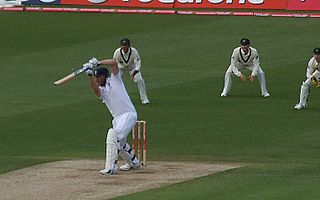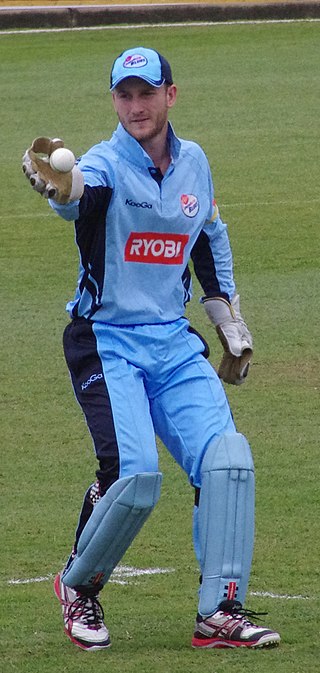Related Research Articles

An all-rounder is a cricketer who regularly performs well at both batting and bowling. Although all bowlers must bat and quite a handful of batsmen do bowl occasionally, most players are skilled in only one of the two disciplines and are considered specialists. Some wicket-keepers have the skills of a specialist batter and have been referred to as all-rounders, but the term wicket-keeper-batter is more commonly applied to them, even if they are substitute wicket keepers who also bowl.
Cricket is a sport that generates a variety of statistics.

In cricket, an extra is a run scored by, or awarded to, a batting team which is not credited to any individual batter. They are the runs scored by methods other than striking the ball with the bat.

In cricket, a dismissal occurs when a batter's innings is brought to an end by the opposing team. Other terms used are the batter being out, the batting side losing a wicket, and the fielding side taking a wicket. The ball becomes dead, and the dismissed batter must leave the field of play for the rest of their team's innings, to be replaced by a team-mate. A team's innings ends if ten of the eleven team members are dismissed. Players bat in pairs so, when only one batter remains who can be not out, it is not possible for the team to bat any longer. This is known as dismissing or bowling out the batting team, who are said to be all out.
Sir Cuthbert Gordon Greenidge is a Barbadian retired cricketer who represented the West Indies in Test and One Day International (ODI) teams for 17 years, as well as Barbados and Hampshire in first-class cricket. Greenidge is regarded worldwide as one of the greatest and most destructive opening batsmen in cricket history. In 2009, Greenidge was inducted into the ICC Cricket Hall of Fame. He was a member of the squads which won the World Cups in 1975, 1979 and runners-up in 1983.
Obstructing the field is one of the nine methods of dismissing a batsman in the sport of cricket. Either batsman can be given out if he wilfully attempts to obstruct or distract the fielding side by word or action. It is Law 37 of the Laws of cricket, and is a rare way for a batsman to be dismissed; in the history of cricket, there has been only two instances in Test matches, nine in One Day International (ODI) matches, and six in Twenty20 International matches. There have also been seven instances in Test cricket, and two in ODIs, where a batsman has been dismissed handled the ball, a mode of dismissal now folded into obstructing the field.
Timed out is a method of dismissal in the sport of cricket. It occurs when an incoming batter is not ready to play within a given amount of time of the previous batter being either dismissed or retired. This is one case of a 'diamond' or 'platinum' duck, as the player is out without having faced a ball. The first batter in international cricket to be dismissed by this method is Angelo Mathews, playing against Bangladesh in the ICC Men's Cricket World Cup 2023. The purpose of the law is to ensure there are no unnecessary delays to the game. It is easily avoided, and it is very unusual for a batter to get out 'timed out'. As of December 2023, there have been no instances of this type of dismissal in Test cricket, a single instance in one day international cricket, and six instances in first-class cricket as a whole. The first batter in Twenty20 International cricket to be dismissed by this method is Godfred Bakiweyem against Sierra Leone in the 2023 Africa Cricket Association Africa T20 Cup.
A substitute in the sport of cricket is a replacement player that the umpires allow when a player has been injured or become ill, after the nomination of the players at the start of the game. The rules for substitutes appear in Law 24 of the Laws of Cricket.

In cricket, a batsman is not out if they come out to bat in an innings and have not been dismissed by the end of an innings. The batsman is also not out while their innings is still in progress.
Enid Bakewell played for the English women's cricket team in 12 Tests between 1968 and 1979, and in 23 one-day international matches. A right-handed batter and slow left-arm orthodox bowler, on her figures she has a strong claim to be regarded as the best all-rounder that the English women's game has produced. In Tests she scored 1,078 runs at an average of 59.88, with 4 centuries, as well as taking 50 wickets at an average of 16.62. In what proved to be her final Test, she scored 68 and 112* and took 10 for 75 against West Indies at Edgbaston in 1979. Her final WODI appearance was in the final of the 1982 Women's Cricket World Cup.

Angelo Davis Mathews is a professional Sri Lankan cricketer and a former captain of the national cricket team in all formats. Mathews currently plays all formats for Sri Lanka., Mathews was a key member of the team that won the 2014 ICC World Twenty20 and was part of the team that made the finals of 2011 Cricket World Cup, 2009 ICC World Twenty20 and 2012 ICC World Twenty20. Mathews and Lasith Malinga hold the record for the highest ninth wicket partnership in ODI cricket.

Grant David Elliott is a former New Zealand cricketer, who played all formats of the game. Primarily a batting all-rounder, Elliott contributed a man of the match performance to provide entrance to New Zealand's first ever World Cup final, by beating South Africa in 2015. Domestically, he played for Wellington. He was also a part of the New Zealand squad to finish as runners-up at the 2015 Cricket World Cup.
The nervous nineties is a commonly used term in cricket.

James Michael Vince is an English cricketer who is the captain for Hampshire County Cricket Club and plays for the England cricket team. Vince was part of the England squad that won the 2019 Cricket World Cup. He is a right-handed middle-order batter who is also a right-arm medium pace bowler. He made his international debut for England in May 2015.

Azhar Ali (Urdu: اظہر علی; born 19 February 1985) is a Pakistani former international cricketer. He is former captain of ODI and test side of Pakistan national team.
Pramod Bhanuka Bandara Rajapaksa,, popularly known as Bhanuka Rajapaksa, is a professional Sri Lankan cricketer, who plays limited over internationals for the national team. He is a left-handed batsman who bowls right-arm medium. He was born in Colombo. Despite a prolific domestic career, Rajapaksa only made his international debut when he was called up for the T20I series against Pakistan in 2019, ten years after his first-class debut.

Peter Michael Nevill is an Australian former cricketer who played 17 Tests and 9 T20 internationals for Australia. He also represented New South Wales and the Melbourne Stars, having previously played for the Melbourne Renegades and the Sydney Sixers. He was Australia's regular Test wicket-keeper from the second test of 2015 Ashes series until being dropped in November 2016. He made his Twenty20 International debut for Australia against South Africa on 4 March 2016. He retired in April 2022.
Sonam Tobgay is a Bhutanese sportsman who has represented his country in both, cricket and football.
References
- 1 2 3 4 "Law 25 – Batsman's Innings; Runners". MCC. Retrieved 29 September 2017.
- ↑ "Records / Test matches / Batting records / Unusual dismissals". ESPNcricinfo . Retrieved 8 January 2022.
- ↑ "Full Scorecard of Bangladesh vs Sri Lanka 2nd Match 2001/02". ESPNcricinfo . Retrieved 8 January 2022.
- ↑ "Lanka 'ridicule' cricket". The Tribune . Archived from the original on 3 March 2016. Retrieved 8 January 2022.
- ↑ "April 30, 1983: Gordon Greenidge and the 'Tragic Century'". News18. 30 April 2017. Retrieved 8 January 2018.
- ↑ "Born to keep". ESPN Cricinfo. 3 May 2006. Retrieved 1 May 2018.
- ↑ Das, Rituparna (30 April 2018). "Flashback: When Gordon Greenidge left his innings incomplete to tend to his sick daughter". CricTracker.
- ↑ Liew, Jonathan (7 June 2022). "The rise of tactical batting retirements: intriguing innovation or just not cricket?". The Guardian .
- ↑ "Explainer: What is retired out, why did R Ashwin depart in this manner and other similar incidents". Firstpost. 11 April 2022. Retrieved 11 April 2022.
- ↑ "Retired out: Ashwin, RR think out of the box". The Indian Express. 11 April 2022. Retrieved 11 April 2022.
- ↑ "R Ashwin becomes first batter to be tactically retired out in the IPL". ESPN Cricinfo. Retrieved 10 April 2022.
- ↑ "Birmingham seal rain-affected last-ball thriller by one run". ESPN Cricinfo. Retrieved 5 June 2022.